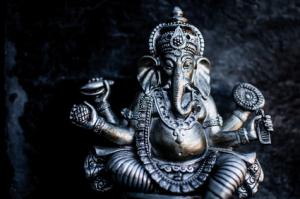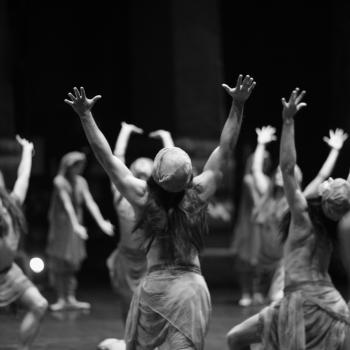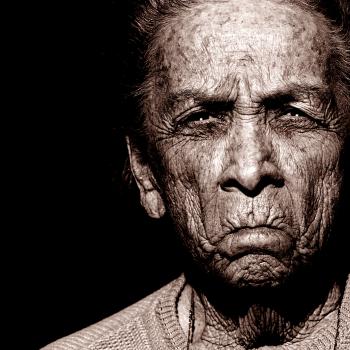 Let’s say you’re reading this on your laptop in a coffeeshop. Complete strangers picked grew and picked coffee beans, milked cows, and trucked those products to market. Another stranger exchanged your latte for arbitrary tokens – either bits of colored paper or mere digital 0s and 1s. And at some point workmen installed electrical lines and cable for the wifi. We’re talking about cooperation: people playing the roles they’re supposed to, making complicated sacrifices, all in order for civilization to keep trundling along. How did we homo sapiens get so cooperative? Many scholars think “big god” religions – whose deities care about morality – played a role, but a controversial new paper in Nature suggests that big gods come after, not before, complex civilization. Other scholars have taken issue with the Nature paper’s methods and conclusions. Come with me into the whirling center of a scientific controversy.
Let’s say you’re reading this on your laptop in a coffeeshop. Complete strangers picked grew and picked coffee beans, milked cows, and trucked those products to market. Another stranger exchanged your latte for arbitrary tokens – either bits of colored paper or mere digital 0s and 1s. And at some point workmen installed electrical lines and cable for the wifi. We’re talking about cooperation: people playing the roles they’re supposed to, making complicated sacrifices, all in order for civilization to keep trundling along. How did we homo sapiens get so cooperative? Many scholars think “big god” religions – whose deities care about morality – played a role, but a controversial new paper in Nature suggests that big gods come after, not before, complex civilization. Other scholars have taken issue with the Nature paper’s methods and conclusions. Come with me into the whirling center of a scientific controversy.
The Nature paper, “Complex societies precede moralizing gods throughout world history,” was published in April to significant media acclaim. “Big Religion May Have Gotten too Much Credit for the Evolution of Modern Society,” claimed Scientific American. The website Science Daily reported that “Complex societies gave birth to big gods, not the other way around.” What was the data behind this electrifying finding?
The Seshat Databank
The paper’s lead author, Harvey Whitehouse, heads up Oxford University’s Center for the Study of Social Cohesion. With an international team of collaborators, he’s been working to build a comprehensive database of world history and culture for researchers to test hypotheses related to cultural evolution. The database, Seshat: Global History Databank, uses ethnographic and historical literature sources to code variables related to social complexity, religion, and other topics for geographic and cultural zones across the world and throughout history. Research assistants comb through the literature, find the appropriate data, and fill in the appropriate variables.
For example, research assistants coded the 19th-century Ashanti Empire in present-day Ghana as relatively high in complexity due to the attested presence of high population and extensive governmental hierarchy (prior to British colonization, anyway). A few thousand miles away and several millennia back, The Classic Old Kingdom of ancient Egypt was coded as having highly routinized religion with a moralizing high god. This coding was on the basis of records showing that Classic Old Kingdom priests offered sacrifices in the temple three times a day, and that the goddess Ma’at was keenly interested in whether her people behaved according to the precepts of cosmic order and balance.
Research assistants (RAs) – who aren’t yet fully trained, PhD-level researchers, but usually undergraduates or master’s students – are supposed to consult with subject-area experts when coding variables. This expert advice can clear up conflicts or ambiguity in the written records – a key role, since ethnographic and historical records commonly disagree with one another. What’s more, the Seshat databank is supposed to allow for annotation of multiple perspectives on any given issue when experts don’t agree – for example, whether imperial Ashanti society had instruments of credit and debit. Expert vetting is intended to ensure that RAs don’t misread sources and populate the databank with unreliable data.
As the databank gets filled in with fine-grained information on complexity and religion, researchers are supposed to be able to use all that data to test hypotheses about how societies develop and change over time. For example, do cultures with more complex governments also tend to have complicated religious systems? If so, which comes first?
Big Gods: Cause or Consequence of Complexity?
A key hypothesis in the field of cultural evolution – the “big gods hypothesis” – predicts that omniscient, morally concerned deities help make large-scale cooperation possible by encouraging people to behave properly and obey norms, even when many social and economic interactions are anonymous and ephemeral.
In small-scale societies, trust runs on reputation and reciprocity. People behave well largely because they know they’ll see each other again. If they cheat or hurt one another, they know others will hear about it, and their reputation will suffer. It’s a bit like living in a small town: everyone knows your business. But in large-scale cultures, this “grapevine” approach to morality doesn’t work. Maybe – the theory goes – belief in all-knowing gods who care whether people behave ethically is what allowed large-scale societies, like empires and kingdoms, to form.
But the Nature paper by Whitehouse et al. claims that this effect ran the other way around – complex societies evolved first, and moral high gods came afterward. The authors combined 51 variables of society size, hierarchical organization, and related measures into a single measure of social complexity. They then tested 12 geographic regions across the world that contained data for social complexity both before and after the first records of moralizing high gods, using time periods of one century. According to their analyses, social complexity increased faster before the appearance of moral high gods than after. In 10 of the 12 regions, evidence for moral high gods appeared in the Seshat database within a single century of the regions’ having exceeded a complexity threshold of .6 (on a scale from 0 to 1). The authors call this level of complexity a “megasociety,” comprising a million or more inhabitants. They therefore interpreted their findings to indicate that big gods are a consequence, not a cause, of social complexity and high-intensity cooperation.
Controversy
Others weren’t so convinced. Bret Beheim, an ecological anthropologist at the Max Planck Institute for Evolutionary Anthropology, led a re-analysis of the Seshat data and, with a team comprising researchers around the world, produced a preprint paper that takes issue with some of the original paper’s findings. To add to the excitement, a separate critique of the Nature paper, written by historians with reservations about the data collection and coding methods in Seshat, is also forthcoming in the Journal of Cognitive Historiography.
I’ll focus on the preprint paper by Beheim and colleagues. What’s at stake is a complicated and sticky ball of wax, but the basics are relatively straightforward. One issue that Beheim and his co-authors raise is that many of the data points in the Seshat databank aren’t independent. Each geographic region or polity contains data putatively broken up into century-long intervals, so that you can see whether or not Greek civilization – for example – had a certain level of complexity in 700 BCE, 600 BCE, or 500 BCE. But for many of these century-long data points, previous data is simply filled in from the previous century, without any indication that a separate source was consulted or a unique measurement taken. This means that the Seshat databank is more coarse-grained than it initially appears to be, making it difficult to carry out certain kinds of statistical analysis.
More importantly, though, is the problem of missing information. In the specific dataset used for Whitehouse et al.’s Nature paper, each century-long interval for every geographic region had a binary value for the presence or absence of moral high gods (or their equivalent, “broad supernatural punishment”). The idea is that researchers should be able to get a longitudinal picture – one extended over time – of precisely when moralistic religious beliefs made their first appearance in any given region. But in examining the dataset and analyses, Beheim et al. found that most of the negative data points for big gods – data points showing the known absence of big gods for a given century – were in fact originally marked as “NA,” or “data not available.” What this means is that Whitehouse and his co-authors decided to code missing data for big gods as positive evidence of the absence of big gods. Beheim et al. write:
in total, 61% (n =490) of all outcome observations, and 98% of alleged cases of ‘moralizing gods absent,’ were originally unknown values in Seshat. The resulting correlation between ‘having any outcome data at all’ (not ‘NA’) and recording ‘moralizing gods present’ is r = 0.97, suggesting that the study is essentially an analysis of the missingness patterns in Seshat.
Societies with no available values for big gods in the original dataset tended to be very small, to be illiterate, and to have low levels of social complexity. But as Beheim et al. point out, this means that re-coding those values simply as “known absent” biases the study in favor of Whitehouse et al.’s conclusion. When Beheim et al. re-ran analyses with missing values simply coded as missing, their results suggested that big gods are likely to show up in a society before social complexity starts increasing.
Beheim and his colleagues were also concerned that the tight relationship between social complexity and religious type could bias the data in favor of later appearances for big gods. Specifically, they showed that, in most of the societies analyzed for the Nature paper, big gods appeared almost precisely when writing first appeared. This is a problem because the Seshat databank depends on written records for its data. If a society hadn’t developed literacy by a given time, then by definition there wouldn’t be any records about their religion. The fact that the first appearance of big gods in the Seshat databank so often coincides with the precise historical moment when a society first developed written records raises the distinct possibility that many societies had big gods prior to achieving literacy, but simply couldn’t record those beliefs.
In fact, ethnographic research suggests that many small-scale societies do have gods and spirits who care about humans’ behavior. One meta-analysis of more than 40 ethnographies covering 18 hunter-gatherer (foraging) societies found that every single group believed that gods or spirits punish humans for antisocial or harmful actions. The idea that moralizing gods are a unique feature of complex societies is therefore questionable. At the very least, the ethnographic record hints that many societies have moralizing gods for some time before becoming literate.
The smallest possible time window in the original study was one century, remember. What if we move the first appearance of moralizing high gods back in time only one century, to correct for this potential “forward bias” of the Seshat data? Beheim and his colleagues showed that this correction reverses Whitehouse et al.’s finding: the results indicate that big gods come before, not after, steep rises in social complexity.
This correction doesn’t necessarily mean that Whitehouse et al.’s findings are no good at all. Rather, they simply illustrate that the entirety of the original paper’s conclusions depend on a very narrow time window. As I mentioned above, Whitehouse et al. found that, in most societies, big gods appeared within a single century of a society’s achieving high levels of complexity. This is a slim margin of error. You have to be very sure that the indicated century really is exactly when big gods actually appeared in order to draw firm conclusions. But Beheim and colleagues argue – I think convincingly – that we’re not actually that sure.
Building a Cross-Cultural, Historical Database is Hard
There are also some questions about the reliability of the Seshat data. Specifically, some of the subject matter experts – the quality-control researchers who are intended to be providing feedback and vetting for research assistants’ work – appear to disagree with the managers of the Seshat databank regarding how much work they actually contributed. Beheim et al. write:
one of Seshat’s more prolific scholars (Dr. Vesna Wallace), originally credited with having vetted the religion and ritual variables for 49 polities in 7 NGAs, in fact reports having played no role whatsoever in supervising coding or vetting any portion of the site.
The Cognitive Historiography paper goes into more detail:
Prof. Wallace, has, when contacted by a member of our team, expressed surprise at any mention of her as expert vetter on the Seshat site, noting that she had no part in any aspect of coding, vetting or recommendation of sources, and that most of the NGAs where she is listed are entirely outside her area of expertise.…According to Wallace, her involvement with the Seshat project was limited to attending a basic informational session and then having a private conversation with one of the Nature authors about one or two basic issues in Indian and Mongolian Buddhism.
If this claim is true, it raises questions about how much vetting is actually going on in the Seshat databank. This matters because, as we’ve seen, even tiny differences in data values can make a world of difference when testing complex hypotheses. The data need to be rock-solid; if they’re not, results will always come with a big asterisk.
Ongoing Conversation
Despite their critiques, Beheim et al. and Edward Slingerland et al. – the authors of the Cognitive Historiography rebuttal – both emphasize the value of Whitehouse and his colleagues’ project: the creation of a large, cross-cultural database for testing historical and cultural-evolutionary hypotheses. The world needs exactly this kind of resource, which is precisely why it’s so important to get it right.
It’s worth noting that Edward Slingerland, a professor of religious studies at the University of British Columbia – Vancouver, is spearheading the construction of a separate database, the Database of Religious History, which uses different methods and quality controls to produce historical, cross-cultural data about religious variables across known societies. The upshot is that there are two alternative databases under construction, supported by the efforts of hundreds of experts and research staff. In principle, researchers will soon be able to test hypotheses using the two databases and compare results, allowing for more fine-grained analyses of predictions and results. In the meantime, there may be some rivalries between the two teams. While blood might occasionally run hot, the history of science shows that discovery and advancement often benefit from healthy rivalries between experts.
Rebuttals to the Rebuttal
Speaking of which: Patrick Savage, a professor of musicology and expert in cross-cultural studies at Keio University in Japan and one of the Nature paper’s co-authors, understandably disagrees with Beheim et al.’s conclusions. In a blog post at Nature, he responds that 6 of the 12 societies analyzed in the original paper gained big gods only through military conquest. For example, ancient Pakistan gained belief in a big, moralizing god only because the Achaemenid Persians conquered it, bringing Zoroastrianism along with them.
Savage points out that it’s unreasonable to assume that the data in this case might be forward biased, since there’s no way for Zoroastrianism to have somehow been somewhere 100 years before it was there. Running analyses on the remaining 6 societies, Savage finds that correcting for forward bias leaves the original paper’s conclusions unchanged. Similarly, other authors of the Nature paper have challenged critiques on the blog of co-author Peter Turchin. They say they’re preparing a comprehensive response to the critiques for peer review.
The Upshot
All parties generally agree that there’s some correlation between the complexity of a society and the type of religion it upholds. Whether the big gods come first or later, they probably at least help sustain high levels of disinterested cooperation. As Whitehouse and colleagues put it,
even if moralizing gods do not cause the evolution of complex societies, they may represent a cultural adaptation that is necessary to maintain cooperation in such societies once they have exceeded a certain size, perhaps owing to the need to subject diverse populations in multi-ethnic empires to a common higher-level power.
Even while disagreeing heartily with Whitehouse et al.’s major conclusions, Beheim and his colleagues concur that the relationship between big gods and social complexity probably isn’t straightforward and linear. Rather, moral high gods and social complexity probably co-evolve in a feedback loop between culture and cognition. And while many small-scale societies do have gods and spirits that care about human morality, the type of moral behaviors and the scope of moral questions seems to change with increases in social complexity. Namely, in big societies, big gods care more about impersonal fairness, and are more likely to defer their punishments or rewards to an afterlife. So rather than talking about the evolution of moralizing gods, we should be talking about specific kinds of moralizing gods and types of religion.
All societies depend on cooperation. But what counts as cooperation varies from setting to setting. In complex, large-scale civilizations, cooperation often requires trusting anonymous strangers and accepting delayed gratification. The big gods that scholars such as Whitehouse are interested in are ultimately those that care about these things. By contrast, the gods of smaller-scale societies often care about observing proper taboos, as well as about not harming other members of the tribe. In all societies, religion and ritual have to do with morality. But slow, difficult scientific work is needed to uncover what types of moralities fit with which types of societies – and which types of gods.












